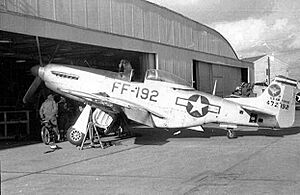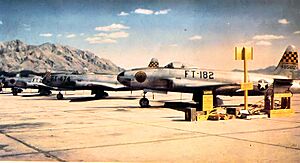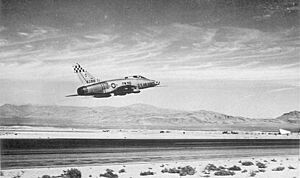Nellis Air Force Base facts for kids
Nellis Air Force Base, often called simply Nellis, is a very important United States Air Force base located in southern Nevada. It's like a huge training ground where pilots and aircrews learn advanced combat skills. Nellis is famous for hosting big air combat exercises such as Exercise Red Flag and Green Flag-West. These exercises help pilots practice flying and fighting in realistic situations, often using the nearby Nevada Test and Training Range (NTTR) for their training missions.
Quick facts for kids Nellis Air Force Base |
|||||||||
|---|---|---|---|---|---|---|---|---|---|
| Las Vegas, Nevada in the United States of America | |||||||||
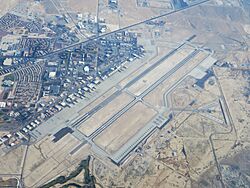
An aerial view of Nellis AFB taken in 2014
|
|||||||||
 |
|||||||||
|
Location in the United States
|
|||||||||
| Coordinates | 36°14′57″N 114°59′46″W / 36.24917°N 114.99611°W | ||||||||
| Type | US Air Force base | ||||||||
| Area | 4,600 ha (11,300 acres) | ||||||||
| Site information | |||||||||
| Owner | Department of Defense | ||||||||
| Operator | United States Air Force | ||||||||
| Controlled by | Air Combat Command (ACC) | ||||||||
| Open to the public |
Yes, with restrictions (Thunderbirds Museum and tours) | ||||||||
| Condition | Operational | ||||||||
| Site history | |||||||||
| Built | 1941 (as Las Vegas Army Airfield) | ||||||||
| In use | 1941 – present | ||||||||
| Garrison information | |||||||||
| Current commander |
Colonel Joshua DeMotts | ||||||||
| Garrison | 99th Air Base Wing (Host) | ||||||||
| Occupants |
|
||||||||
| Airfield information | |||||||||
| Identifiers | IATA: LSV, ICAO: KLSV, FAA LID: LSV, WMO: 723865 | ||||||||
| Elevation | 569.6 metres (1,869 ft) AMSL | ||||||||
|
|||||||||
Contents
- The History of Nellis Air Force Base
- What Nellis Air Force Base Does Today
- Geography of Nellis Air Force Base
- Based Units at Nellis Air Force Base
- Images for kids
- See also
The History of Nellis Air Force Base
Nellis Air Force Base has a long and interesting history, starting even before World War II. It was first used as a simple landing strip for mail planes.
Early Days as McCarran Field
In the 1930s, the airfield north of Las Vegas was known as McCarran Field. The city of Las Vegas bought the field in January 1941. Soon after, the Army started building more facilities there. By the time of the attack on Pearl Harbor in December 1941, the airfield already had planes like the AT-6 Texan and Martin B-10 bombers.
Las Vegas Army Airfield During World War II
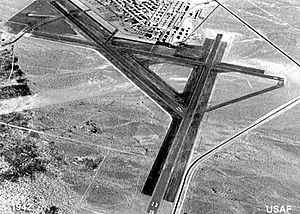
The base officially became Las Vegas Army Airfield on December 20, 1941. It quickly became a key training center for gunners. In January 1942, gunnery training began, teaching soldiers how to shoot from planes.
During World War II, the base trained over 45,000 B-17 gunners. They even filmed a training movie called The Rear Gunner there in 1943. By 1944, students were training with B-17, B-24, and B-40 aircraft. After the war, in September 1945, gunnery training ended, and the base helped soldiers return to civilian life.
Becoming Las Vegas Air Force Base
On January 13, 1948, the base was renamed Las Vegas Air Force Base. Pilot training began in March 1949, using P-51 Mustangs. By 1950, 3,000 pilots had been trained there. The base also hosted its first Air Force Gunnery Meet in May 1949.
The Birth of Nellis Air Force Base
The base was officially named Nellis Air Force Base on April 30, 1950. It was named after Lieutenant William Nellis, a pilot who died in World War II. This change happened just as the Korean War began, and Nellis quickly started training pilots for combat. The base expanded with longer runways and new buildings between 1951 and 1954.
The USAF Fighter Weapons School
The USAF Fighter Weapons School started at Nellis on January 1, 1954. Its main job was to train instructors in gunnery skills. This school is still a very important part of Nellis today, teaching advanced flying and combat tactics.
Tactical Air Command Takes Over
On February 1, 1958, Nellis AFB became part of the Tactical Air Command. This meant the base's focus shifted to advanced weapons training for pilots. New fighter jets like the F-100 Super Sabre arrived.
Training for Combat Crews
The 4520th Combat Crew Training Wing was formed in May 1961. This wing taught experienced pilots how to use fighter weapons, including air-to-air gunnery, bombing, and aerial refueling. During the Vietnam War, combat-experienced pilots became instructors at Nellis.
The USAF Tactical Fighter Weapons Center
The USAF Tactical Fighter Weapons Center started at Nellis on January 1, 1966. This center is responsible for developing and testing new ways to use fighter weapons. It also supervises important training exercises like Exercise Red Flag, which simulates real combat. The famous United States Air Force Thunderbirds demonstration team moved to Nellis in June 1956.
The 474th Tactical Fighter Wing
The 474th Tactical Fighter Wing moved to Nellis in January 1968. This was the first Air Force wing to use the General Dynamics F-111 aircraft. These planes were even sent to Vietnam for combat missions. The wing's job was to train aircrews and be ready for quick fighter attacks during a crisis. It was eventually closed in September 1989.
The 57th Fighter Weapons Wing
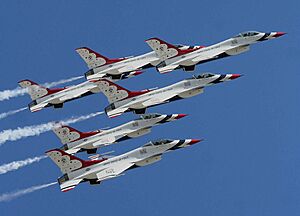
The 57th Fighter Weapons Wing was activated at Nellis in October 1969. This wing continued the advanced training, and the Thunderbirds team was assigned to it in February 1974. The 57th Wing also helped develop realistic combat training, including using "aggressor" squadrons that flew captured Soviet-made planes like the MiG-17 and MiG-21 to simulate enemy aircraft. This helped American pilots learn how to fight against different types of jets.
Air Combat Command Takes Over
Nellis became part of the Air Combat Command on June 1, 1992, after the Cold War ended. The base continued to be a leader in advanced combat training. In 2003, "Aggressor" training was reactivated, where pilots fly like enemy forces to challenge U.S. aircrews. Nellis also hosts the annual Aviation Nation airshow, which began in 2002. In 2007, a large Nellis Solar Power Plant was built on the base, which was visited by President Barack Obama in 2009.
Major Commands and Units at Nellis
Nellis Air Force Base has been home to many important commands and units throughout its history.
- West Coast Air Corps Training Center: April 1941
- Air Training Command: 1942-1958
- Tactical Air Command: 1958-1992
- Air Combat Command: 1992-present
Some of the major units that have been based at Nellis include:
- 79th Air Base Group (1941)
- 82d Flying Training Wing (1943-1946)
- 3595th Pilot Training Wing (1948-1958)
- 4520th Combat Crew Training Wing (1958-1966)
- 4525th Fighter Weapons Wing (1966-1969)
- 474th Tactical Fighter Wing (1968-1989)
- 57th Wing (1969-present)
- USAF Fighter Weapons School (various times, now USAF Weapons School)
- USAF Tactical Fighter Weapons Center (1966-present, now USAF Warfare Center)
What Nellis Air Force Base Does Today
Nellis Air Force Base is known as the "Home of the Fighter Pilot" because it's where the Air Force focuses on advanced combat training. The main unit at Nellis is the USAF Warfare Center. This center plans and runs training exercises for different types of aircraft from the Air Force, Army, Navy, Marines, and even allied nations.
These training exercises mostly happen at the nearby Nevada Test and Training Range (NTTR). The most famous exercises are Exercise Red Flag and Exercise Green Flag (West). These help pilots and ground crews practice working together in realistic combat situations.
As of 2019, Nellis employs about 9,500 military and civilian people. Including families and retired military, the total military population in the area is over 40,000.
The base also helps support operations at other nearby military sites like Creech Air Force Base and the Tonopah Test Range.
Nellis Base Areas
Nellis Air Force Base is divided into three main areas:
- Nellis Area I: This area has the airfield with its two runways, space for many aircraft, recreation and shopping facilities, and most of the main command buildings.
- Nellis Area II: Located northeast of the main base, this area includes the Nellis Gun Club and the 820th Red Horse Squadron, which is a special engineering unit.
- Nellis Area III: West of the main base, this area has family housing, administrative offices, and the Mike O'Callaghan Federal Hospital. It also has some historical storage areas from World War II.
Geography of Nellis Air Force Base
Nellis AFB covers about 11,300 acres in the northeast part of the Las Vegas Valley. This area is a basin surrounded by mountains. Over the years, Nellis has grown, but it still has about 7,000 acres of undeveloped land.
Nellis Air Force Base Complex
The Nellis Air Force Base Complex is a larger group of military areas in southern Nevada. It includes Nellis AFB itself, the huge Nevada Test and Training Range (NTTR), and other smaller areas used for training and testing. These areas are mostly controlled by military units based at Nellis.
Based Units at Nellis Air Force Base
Nellis Air Force Base is home to many important flying and non-flying units. Some units are "Geographically Separate Units" (GSUs), meaning they are based at Nellis but report to a parent unit located elsewhere.
United States Air Force
Air Combat Command
- US Air Force Warfare Center
- 99th Air Base Wing (This is the main host wing for the base)
- 53rd Wing (Focuses on testing and evaluation)
- 53rd Test and Evaluation Group (GSU)
- 422nd Test and Evaluation Squadron (Tests various fighter jets like A-10s, F-15s, F-16s, F-22s, and F-35s)
- 53rd Test and Evaluation Group (GSU)
- 57th Wing (A very important wing for advanced training)
- US Air Force Weapons School (Trains expert pilots in different aircraft like F-35s, F-16s, F-15s, and A-10s)
- 57th Operations Group
- 64th Aggressor Squadron (Flies F-16s to simulate enemy aircraft)
- 65th Aggressor Squadron (Flies F-35s to simulate enemy aircraft)
- US Air Force Air Demonstration Squadron (Thunderbirds) (The famous F-16 demonstration team)
- Fifteenth Air Force
- 563rd Rescue Group (Operating Location-Alpha (OL-A)) (GSU) (Includes rescue squadrons with HH-60G Pave Hawk helicopters)
- 800th RED HORSE Group (Special engineering and construction unit)
- Sixteenth Air Force
- 365th Intelligence, Surveillance and Reconnaissance Group (GSU) (Focuses on intelligence gathering)
Air Force Materiel Command (AFMC)
- Air Force Test Center
- 413th Flight Test Squadron (GSU) (Tests HH-60G Pave Hawk helicopters)
Air Force Reserve Command (AFRC)
- Tenth Air Force
- 926th Wing (A Reserve unit that supports training with various fighter jets)
Air National Guard (ANG)
- Nevada Air National Guard
- 232nd Combat Training Squadron (GSU)
Department of Defense
United States Strategic Command
- Joint Electromagnetic Preparedness for Advanced Combat (Works on electronic warfare readiness)
Images for kids
-
The Las Vegas Army Airfield had three runways in 1942, the year Tonopah Army Airfield opened in August (the Tonopah Bombing Range had been divided in 1941 into the Tonopah and Las Vegas General Ranges).
-
Fighter Weapons School F-80As c. 1950 in front of Frenchman Mountain, which is east of the valley
-
The United States Air Force Thunderbirds
See also
 In Spanish: Base de Nellis de la Fuerza Aérea para niños
In Spanish: Base de Nellis de la Fuerza Aérea para niños



